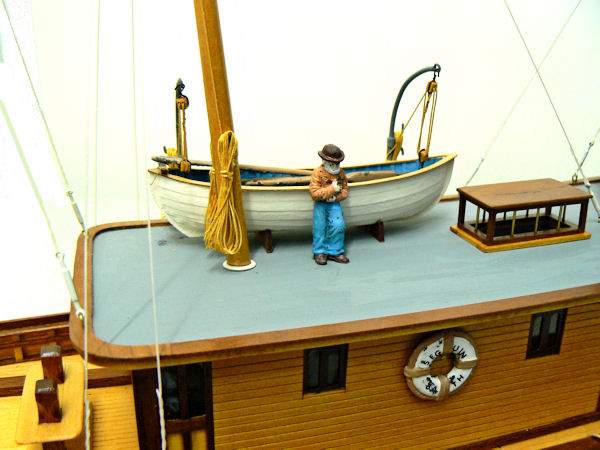PRESENTED is a custom built model made
by a master craftsman which is complete down to the last detail. The Tugboat Seguin was launched in Maine in 1884. Named
after an Island at the mouth of the Kennebec River in Maine, the Seguin was our nation’s oldest operating
steam powered tugboat.
This model is built from the original builder’s plans, and
should not be confused with inexpensive imports. All the hardware and fittings are individually hand made in metal, and
exactly duplicate what was used on the real boat. Inside the pilothouse are even a table and other
bridge deck fittings. The hull, deck and deckhouse are hand laid planking. The bottom paint is maroon
with draft markings at the bow. Special effort was made on this project to replicate the details of the original
down to last minute detail as can bee seen in pictures.
|
Outstanding detail of the highest quality
|
CONDITION: All the gear and fittings are in place and nothing
is broken or missing. The overall appearance of the model is impressive. “Museum Quality” is a hackneyed phrase which
is much over used, but is quite fitting to describe this work-of-art.
MODEL DIMENSIONS: 26″ L x 5″ W x 17″H
CASE: 31 1/2″ L x 10″ W x 21″ H
WEIGHT: 15 1/2 Lbs
|
Dust cover style case is included
|
Mounted
on a base with dust cover, she makes an incomparable model. A perfect addition to your
home, den or office
|
Ship’s boat, davits and old salt
|
|
|
 BRIEF HISTORY: The tug
BRIEF HISTORY: The tug
Seguin was the single-most historically important Maine vessel artifact, that had been donated to the Maine Maritime Museum
for restoration. Launched in 1884, the Seguin had seen the full scope of history on the Kennebec River, assisting at the launchings
of hundreds of Kennebec-built vessels. Acquired by the museum in Bath in 1969, she was hauled in 1977 at Percy & Small’s
north ways, where a ship-house facility was built over it, and the search for sound wood begun. None was to be found. Seguin
was not to reach her 1984 centenary, as many had hoped. By 1988, defeated by the magnitude of the decay of the vessel, ironically
and wrenchingly, the Museum had to dismantle its own ultimate artifact. The old tug was dissected into a sub-collection of
over 350 separate items, ranging from coffee-cans of nuts up to the enormous compound engine. A program of documentation,
publication, and exhibition of these was undertaken that continues to this day.

BRIEF HISTORY: The tug





